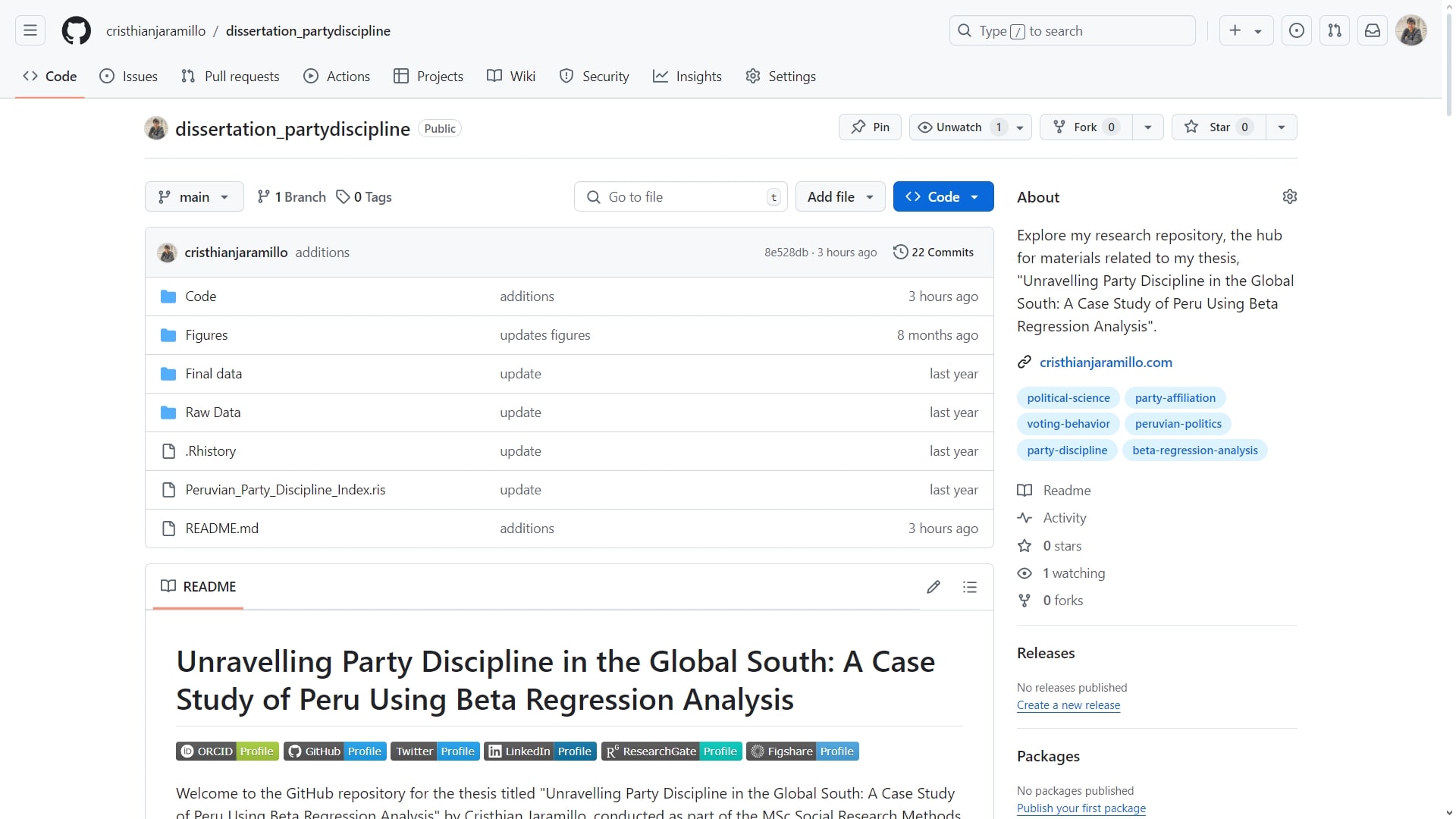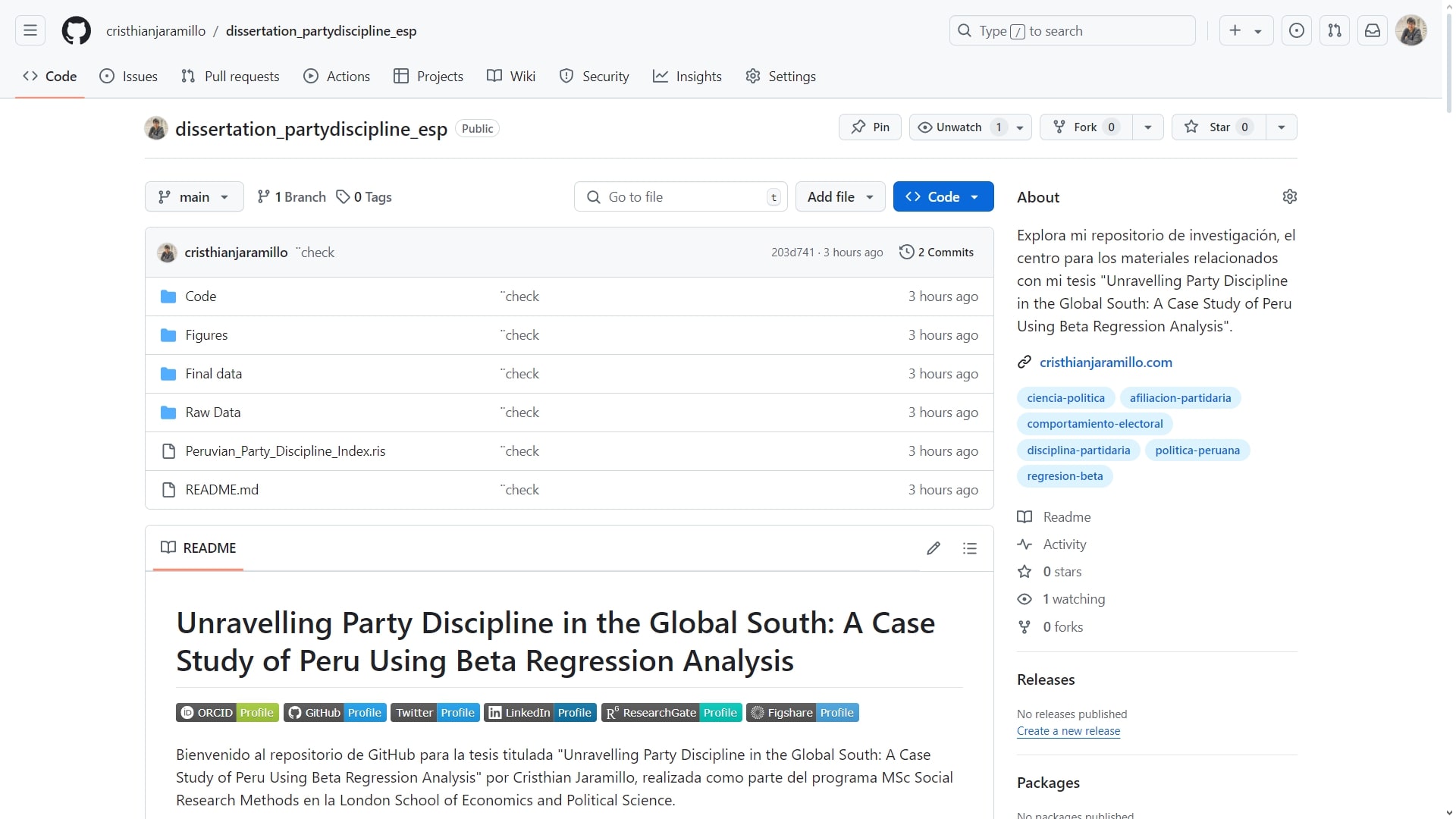Page not found. Your pixels are in another canvas.
Sitemap
A list of all the posts and pages found on the site. For you robots out there, there is an XML version available for digesting as well.
Pages
Welcome to my academic page!
About me
Posts
Peru is a broken country that still marches for its democracy
Published:
“Peru is a deeply fragmented country, where the political class disregards the common good for personal gain.”
To save its democracy, Peru must confront its crimes
Published:
“Peru needs a moral reform: to acknowledge the victims, punish those responsible, and ensure that state violence is never repeated. No democracy can stand on the denial of the pain it has caused.”
Violence, impunity and memory
Published:
“There is no democracy without memory, nor justice without accountability. Latin America deserves better than this violent normality.”
How long can Peruvian democracy endure?
Published:
“Instead of correcting its institutional weaknesses, Peru continues to deepen its crisis. A semblance of democratic governance persists, but its foundations are increasingly fragile.”
What drives change in election years?
Published:
“This analysis highlights the complex interplay of political, economic, and social factors in driving election-year reforms. Affirmative action policies consistently increase the odds of reforms, reflecting their importance as tools for addressing inclusion and equity.”
What is behind authoritarian nostalgia?
Published:
“Not only in Peru, but in other countries, former dictators are remembered with nostalgia, and some even argue that, under their mandate, economies were more solid, crime was controlled or better “values” were promoted (…) omitting the devastating consequences that these governments have had.”
Electronic voting: advancing at a prudent pace
Published:
“Electronic voting, whether in-person or remote, is the technological promise to modernize elections worldwide. Speed, accuracy, and inclusion are the key words for this tool, designed to address the logistical challenges of traditional elections.”
Peru: a lesson for Latin America
Published:
“Peru is at a political crossroads. The organization of transparent and fair elections, although crucial, is not enough to fully sustain the rule of law.”
The constant changes: reforms to the electoral systems of the legislatures in Latin America
Published:
“Reforming should be a process resulting from thorough analysis, but the frequency of these changes in Latin America seems to indicate the opposite.”
Peru 2022: A democracy carrying burdens
Published:
“The response to the protests has been an “institutionalized disdain.” (…) Far from attempting to establish a dialogue with the protesters, part of the Peruvian establishment has chosen to ignore the excesses of the police and armed forces.”
The Peruvian political parties under examination!
Published:
“Decentralization created a new scenario of political competition, new actors, and a new agenda. These changes also impacted the party dynamics, revealing the difficulties political parties face in fulfilling their basic functions of representation and interest aggregation.”
House of Cards: Peru´s Political Turmoil
Published:
“Peru finds itself engulfed in a political maelstrom amidst government changes and clashes between Congress and the President. What drives this “new normal” in Peruvian democracy?”
Fake News, sore losers, and elections
Published:
“The spread of fake news in Peru demonstrates the importance of the role of electoral bodies in their educational function. Both the ONPE and the JNE show that the best course of action is proactive and transparent information. Moreover, it’s evident that merely refuting fake news isn’t enough, as they will continue to circulate and be shared.”
The Eternal Peruvian Crisis: Beyond Pedro Castillo
Published:
“An explanation on governance and why analyzing the Peruvian government system is crucial to prevent a crisis.”
The Crisis in Peru: Political Causes and a Necessary Police Reform
Published:
“In a full democracy, no one should be injured or die for protesting.”
The Perpetual Peruvian Crisis: Some Notes on Its Causes and the Uncertain Political Future
Published:
“In less than two weeks, Peru has experienced one of the worst political crises in decades. What happened, and why is it highly likely that the crisis will repeat?”
portfolio
Portfolio item number 1
Short description of portfolio item number 1
Portfolio item number 2
Short description of portfolio item number 2 
projects
publications
Las cuotas electorales. Un análisis multinivel de los efectos de su aplicación
Published in ONPE, 2019
Recommended citation: Jaramillo, Cristhian and Manuel Valenzuela. (2019). "Las cuotas electorales. Un análisis multinivel de los efectos de su aplicación." Lima: ONPE.
Download Paper
Cuando caen los chicos y no los grandes: la corrupción a nivel subnacional en los casos de Callao y Tumbes
Published in Politai, 2019
Recommended citation: Jaramillo, Cristhian. (2019). "Cuando caen los chicos y no los grandes: la corrupción a nivel subnacional en los casos de Callao y Tumbes." Politai. 10(18): 9-39.
Download Paper
La participación política y el abstencionismo: breves definiciones en el marco latinoamericano
Published in Sanciones, multas y abstencionismo electoral en el Perú. Tres estudios sobre participación electoral y voto obligatorio, 2019
Recommended citation: Jaramillo, Cristhian. (2019). "La participación política y el abstencionismo: breves definiciones en el marco latinoamericano" In: Sanciones, multas y abstencionismo electoral en el Perú. Tres estudios sobre participación electoral y voto obligatorio edited by Manuel Valenzuela. Lima: ONPE.
Download Paper
Elecciones municipales complementarias en distritos post conflicto electoral en Perú
Published in Araucaria. Revista Iberoamericana de Filosofía, Política y Humanidades, 2020
Recommended citation: Bustos, Pamela, Cristhian Jaramillo, & Manuel Valuenzuela. (2020). "Elecciones municipales complementarias en distritos post conflicto electoral en Perú." Araucaria. Revista Iberoamericana de Filosofía, Política y Humanidades. 22(43): 419-438.
Download Paper
Perú: Elecciones Regionales y Municipales 2022. La continua prevalencia de los movimientos regionales
Published in Revista Elecciones, 2022
Recommended citation: Jaramillo, Cristhian. (2022). "Perú: Elecciones Regionales y Municipales 2022. La continua prevalencia de los movimientos regionales." Revista Elecciones. 21(24): 249-262.
Download Paper
Perú y el voto preferencial: la última aplicación de este sistema
Published in Elecciones 2021: Pandemia, crisis y representación, 2022
Recommended citation: Jaramillo, Cristhian. (2022). "Perú y el voto preferencial: la última aplicación de este sistema." In: Elecciones 2021: Pandemia, crisis y representación edited by Fernando Tuesta. Lima: PUCP.
Download Paper
Perú: reglas fuertes, sistema electoral poco amigable y baja representación descriptiva de las mujeres
Published in La construcción de democracias paritarias en América Latina. Régimen electoral de género, actores críticos y representación descriptiva de las mujeres (1990-2022), 2022
Recommended citation: Jaramillo, Cristhian. (2022). "Perú: reglas fuertes, sistema electoral poco amigable y baja representación descriptiva de las mujeres." In: La construcción de democracias paritarias en América Latina. Régimen electoral de género, actores críticos y representación descriptiva de las mujeres (1990-2022) edited by Flavia Freidenberg & Karolina Gilas. México City: INE, UNAM.
Download Paper
República Dominicana: reglas débiles, partidos esquivos, escasa articulación social y baja representación descriptiva de las mujeres
Published in La construcción de democracias paritarias en América Latina. Régimen electoral de género, actores críticos y representación descriptiva de las mujeres (1990-2022), 2022
Recommended citation: Jaramillo, Cristhian. (2022). "República Dominicana: reglas débiles, partidos esquivos, escasa articulación social y baja representación descriptiva de las mujeres." In: La construcción de democracias paritarias en América Latina. Régimen electoral de género, actores críticos y representación descriptiva de las mujeres (1990-2022) edited by Flavia Freidenberg & Karolina Gilas. México City: INE, UNAM.
Download Paper
The Impossibility of Party Unity in Peru: Party Affiliation, Subnational Electoral Competition and Party Discipline (2011–2019)
Published in Bulletin of Latin American Research, 2023
Recommended citation: Jaramillo, Cristhian. (2023). "The Impossibility of Party Unity in Peru: Party Affiliation, Subnational Electoral Competition and Party Discipline (2011–2019)." Bulletin of Latin American Research. 42(5): 649-662.
Download Paper
COVID-19 y las elecciones en América Latina: el impacto de los procesos electorales en el número de casos registrados
Published in La capacidad de resiliencia de las democracias: elecciones y política en contexto de pandemia, 2024
Recommended citation: Jaramillo, Cristhian. (2024). "COVID-19 y las elecciones en América Latina: el impacto de los procesos electorales en el número de casos registrados." In: La capacidad de resiliencia de las democracias: elecciones y política en contexto de pandemia edited by Flavia Freidenberg. México City: UNAM.
Download Paper
Synthetic Control Methods
Published in Global Observatory of Long Term Care, 2025
Recommended citation: Jaramillo-Huaman, C. and Cartagena-Farias, J. (2025) Synthetic Control Methods. GOLTC Methods Guide series, 5. Global Observatory of Long-Term Care, Care Policy and Evaluation Centre, London School of Economics and Political Science. https://goltc.org/publications/synthetic-control-methods/
Download Paper
talks
The impossibility of party unity in Peru: party affiliation, subnational electoral competition and party discipline (2011-2019)
Published:
Peru’s Congress saw a doubling of parliamentary groups from six to twelve, signaling persistent division. The connection between this division and declining party discipline is attributed to factors like party affiliations and subnational competition dynamics. Exploring how these elements shape Peru’s political scene, this article aims to spark discussions on the complexities of party dynamics.
The symbolic representation of women and the obstacles they face in the Congress of the Republic of Peru (2016-2020)
Published:
Peru’s journey from 4.82% female representation in the Legislative branch to 37.69% in 2021 signifies progress, yet challenges persist. Despite electoral reforms, women face political, institutional, and social barriers.
Elections during the pandemic in Latin America: problems, innovations and lessons learned
Published:
In the midst of a global pandemic, the resilience of democratic processes faced a crucial test. Contrary to fears, elections amidst COVID-19 didn’t intensify reported cases, emphasizing that safeguarding both electoral integrity and public health remains a critical balance in uncertain times.
Safeguarding Political Integrity in a Context of Democratic Backsliding: Evidence from the Peruvian Case
Published:
Our study highlights Peru’s democratic setback post-Odebrecht despite anti-corruption efforts. We aim to understand why trust didn’t recover and explore ways to strengthen political integrity. Through varied methods, we analyze Peru’s politics, focusing on the link between public sentiment, reforms, and anti-corruption actions.
teaching
Statistics for Political Analysis 1 and 2
Undergraduate course, Pontifical Catholic University of Peru, Department of Social Science, 2019
This course delves into variance analysis, partial correlation, and multiple regression—understanding coefficients, handling categorical variables, diagnosing regressions, and specifying models. Additionally, it introduces logistic regression and techniques to identify categories of differing complexities through discriminant, factor, and cluster analysis.
Introducción a modelos estadísticos
Undergraduate course, Observatorio de Reformas Políticas en América Latina, 2025
Este curso ofrece una introducción práctica a la regresión lineal aplicada a las ciencias sociales. Se abordan desde la formulación de hipótesis y construcción de modelos hasta la evaluación de supuestos. El trabajo se realiza en R, promoviendo análisis reproducibles y visualizaciones claras.


